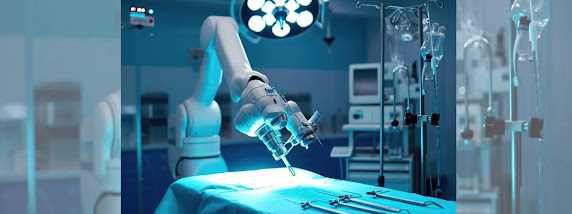"Unveiling the Future of Orthopedics: The Promise of Robotic-Assisted Partial Knee Replacement Surgery"
In the ever-evolving landscape of medicine, technological advancements have reshaped various fields, including orthopedics. Among these innovations, robotic-assisted surgeries stand out, offering heightened precision and tailored treatment pathways for patients. A notable breakthrough in this realm is robotic partial knee replacement surgery. This blog aims to unravel the intricacies of this pioneering surgical approach, delving into its advantages, procedural aspects, and the transformative potential it holds for patients' well-being.
Understanding the Dynamics of Robotic Partial Knee Replacement Surgery
Recent years have ushered in a transformative era in medicine, with technological progress reshaping the landscape of orthopedics. Among these advancements, robotic-assisted surgeries have emerged as a pivotal advancement, offering enhanced precision and tailored treatment avenues for patients. A standout procedure in this realm is robotic partial knee replacement surgery. In this blog, we embark on a journey to unravel the intricacies of this groundbreaking surgical technique, shedding light on its benefits, procedural intricacies, and potential impact on patients' lives.
The Role of Robotics in the Procedure
Robotic-assisted surgery marries the skill of orthopedic surgeons with the precision and accuracy afforded by robotic technology. Central to this technique is the utilization of a robotic arm, manipulated by the surgeon, to conduct the procedure. This robotic arm serves as a conduit for real-time feedback, empowering the surgeon to meticulously plan and execute each surgical step with unparalleled accuracy and finesse.
Benefits of Robotic Partial Knee Replacement Surgery
Personalized treatment: Robotic technology allows for a personalized surgical plan based on each patient’s unique anatomy and condition. This individualized approach results in a better fit and alignment of the prosthetic implant, leading to improved outcomes.
1.Minimally invasive
The minimally invasive nature of this procedure means smaller incisions, reduced tissue damage, and faster recovery time compared to traditional knee replacement surgeries. Patients experience less pain, minimal scarring, and shorter hospital stays.
2. Enhanced Precision in Implant Placement
Through robotic guidance, the Robotic Knee Replacement Surgeon can attain unparalleled precision in positioning the prosthetic implant. This precision ensures optimal stability, a broader range of motion, and increased longevity of the implant, ultimately bolstering the patient's overall joint function and comfort.
3. Accelerated Rehabilitation Process
Thanks to the minimally invasive nature of robotic-assisted surgery, patients experience a swifter initiation of rehabilitation and physical therapy. This expedited rehabilitation timeline facilitates a quicker return to daily activities, fostering a tangible enhancement in the patient's quality of life and overall well-being.
The Robotic Partial Knee Replacement Journey Unveiled
1.Preoperative Planning:
Before embarking on the surgery, meticulous preoperative planning takes precedence. The surgeon initiates this process by obtaining a CT scan of the patient's knee joint, which serves as the foundation for generating a detailed 3D model. Leveraging specialized software, the surgeon meticulously plans the procedure, delineating the optimal positioning of the implant and delineating the necessary bone cuts essential for seamless execution.
2. Intraoperative Guidance:
As the surgery unfolds, the surgeon harnesses the power of the robotic arm to navigate the intricacies of bone cutting and shaping with unparalleled precision. This pivotal aspect of the procedure is facilitated by real-time feedback provided by the robotic system, ensuring adherence to the meticulously crafted preoperative plan.
3. Implantation:
With the bone surfaces meticulously prepared, the surgeon proceeds to implant the prosthetic components within the knee joint. The robotic system assumes a pivotal role in this phase, facilitating precise alignment and balance. This meticulous approach not only enhances functionality but also augments the longevity of the implant, ensuring enduring benefits for the patient.
Postoperative Care and Recovery:
Following the surgery, patients embark on a comprehensive postoperative care regimen, encompassing pain management, tailored physical therapy sessions, and scheduled follow-up visits. While individual recovery timelines may vary, the integration of robotic technology in partial knee replacement surgery often translates to expedited and smoother recoveries compared to conventional approaches, empowering patients to swiftly reclaim their mobility and quality of life.
Varieties of Robotic Knee Replacement:
There are various types of robotic knee replacement procedures available, each designed to address specific areas of the knee joint. The two main types are
1. Medial Compartment Robotic Knee Replacement
This procedure focuses on the inner side of the knee joint and is commonly used to treat patients with isolated medial compartment arthritis.
2. Patellofemoral Robotic Knee Replacement
This technique primarily targets the kneecap (patella) and the groove at the end of the thigh bone (femur). It is suitable for patients with patellofemoral arthritis or specific cases where the patellofemoral joint is affected.
Reimagining Orthopedic Surgery with Robotic Technology:
Robotic partial knee replacement surgery serves as a mere glimpse into the vast potential of robotic technology within orthopedics. As technological advancements persist, robotic systems are poised to assume an increasingly pivotal role across a spectrum of orthopedic procedures, promising enhanced outcomes, abbreviated recovery periods, and heightened patient satisfaction.
Robotic Partial Knee Replacement in India: A Growing Phenomenon
The ascent of robotic partial knee replacement surgery is palpable within India's healthcare domain. Esteemed hospitals and orthopedic centers nationwide are embracing robotic platforms to furnish cutting-edge treatment modalities to patients. Harnessing the prowess of this technology, India's adept orthopedic surgeons are delivering precise and effective partial knee replacements, elevating patient outcomes and overall contentment.
In Conclusion
Robotic partial knee replacement surgery emerges as a pioneering and transformative avenue for addressing knee osteoarthritis. Characterized by its precision and individualized approach, this procedure offers a myriad of advantages, including optimal alignment, minimal tissue trauma, and expedited recovery. As the realm of robotics continues to evolve, anticipations soar for further breakthroughs in orthopedic surgery, ushering in an era of enhanced quality of life for multitudes of patients worldwide.
Seeking Robotic Knee Replacement Surgery in Nizamabad? Feel Free to Contact the Best Robotic Knee Replacement Surgery Specialist . Dr Naveen Malu at Novalife Hospitals- the Top MultiSpeciality Hospital in Nizamabad.


.jpg)
Comments
Post a Comment